|
November 20, 2020
I hope that you and your loved ones are doing well, staying healthy, and looking out for your neighbors and friends in these difficult times.
Our COVID situation here in Oregon and around the country continues to worsen, with another day of record numbers.
Today’s newsletter reports on those metrics and also provides more information on COVID testing in Oregon, including OHA’s response to a letter from legislators demanding improvements in testing and details from today’s news conference laying out a change in the way that COVID tests will be reported.
Please stay safe, and let me know if you have any questions about today’s newsletter.
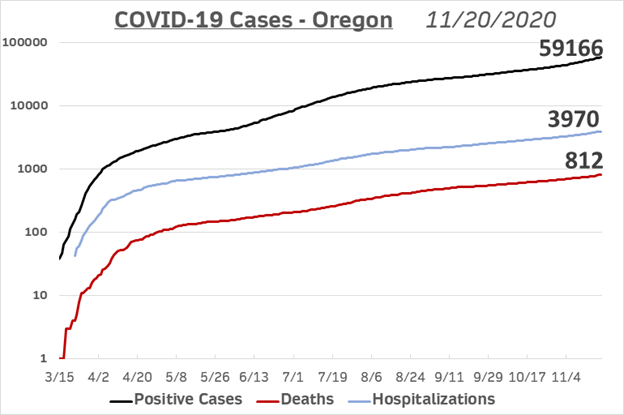
TODAY’S CORONAVIRUS AND CORONAVIRUS RESPONSE UPDATE
-
Positive Cases: OHA reports today that 1,251 additional Oregonians have tested positive for COVID-19. The cumulative total for those testing positive since the beginning of the pandemic is 59,166.
-
Total Tests: The number of reported COVID test results has increased by 8,410. The cumulative total of tests since the beginning of the pandemic is now 990,744.
-
Ratio: The percentage of total tests that have been reported positive is 14.9%. The national ratio today is 10.1%.
-
Deaths: I’m sorry to have to report 4 additional COVID deaths today. You can read about the Oregonians we lost further down in the newsletter. The total number of COVID deaths in Oregon is now 812.
-
Hospitalized: OHA reports a new record 35 new COVID hospitalizations today. The cumulative number of those who have been hospitalized with COVID is now 3,970.
-
Presumptive Cases: OHA is including “presumptive COVID-19 cases” in its daily reports, consistent with recently amended guidance from the Centers for Disease Control and Prevention. A presumptive case is someone who does not yet have a positive PCR test but is showing symptoms and has had close contact with a confirmed case. If they later test positive by PCR, those will be recategorized as confirmed cases. OHA reports 55 new cases presumed positive today. The cumulative total of those reported as presumed positives is 3,009.
-
Other Hospital Information:
- Patients Currently with COVID-19 Symptoms (who may or may not have received a positive test result yet): 458 (39 fewer than yesterday). Of those, 412 have already received a positive test back.
- Available ICU Beds: 111 (7 more than yesterday)
- Other Available Beds: 615 (22 more than yesterday).
- ICU Patients w COVID-19 Symptoms: 99 (8 fewer than yesterday).
- COVID-19 Patients Currently on Ventilators: 38 (3 fewer than yesterday).
- Available Ventilators: 746 (13 more than yesterday).
-
Dashboard:
-
Today’s National Numbers:
-
Additional Brief Updates:
- With the current increases in COVID cases, we have to expect increasing numbers of those dying of the disease. It’s an inevitable mathematical reality. Despite improvements in treatment the national COVID death rate has remained around 1.5% of all cases (it’s currently 1.3% in Oregon) over the last four months. As case numbers increase, so inevitably will deaths (and hospitalizations). The Atlantic has an excellent article going into detail on the relationship between case numbers and severe consequences.
- We’re hearing some promising news about the situation in Europe following a temporary return to COVID restrictions. They are starting to see declines in new cases in a number of countries.
Changes in the Way Tests Are Reported
As I mentioned in yesterday’s newsletter, I and many of my legislative colleagues sent a letter to the Governor calling for more widespread access to testing. Among the arguments that we presented was concern over Oregon’s level of testing when compared to the testing levels in other states.
We’ve just received a response from OHA Director Pat Allen. In it he contends that Oregon’s testing level is comparable to the levels at most other states, but we report tests differently than most. Unlike most states, we have not been reporting every test given, but rather the number of individuals being tested. In other words, if an individual was once tested and has an additional test, e.g., if they’re a health professional or long-term care worker who has been tested periodically and has remained COVID-negative, they are only counted that first time. Most states report each test they are given. By beginning to follow that same methodology, we’ll be able to compare apples to apples.
Under this changed methodology rate, we’ll see our positivity rate go down substantially, though it will still be much higher than we’d like.
This change doesn’t appear to be reflected in today’s reported tests, which are in line with where they have been. I’m not sure when the new methodology will be implemented, but we should see the positivity rate go down from its current record highs. It has been higher than the national rate in recent weeks, despite the fact that other parts of the country are being much harder hit. Now that we know about this difference in reporting methodology, that difference makes more sense.
Here are two explanatory graphs that OHA released today showing the difference in Oregon’s experience when looked at with the two different reporting methodologies:
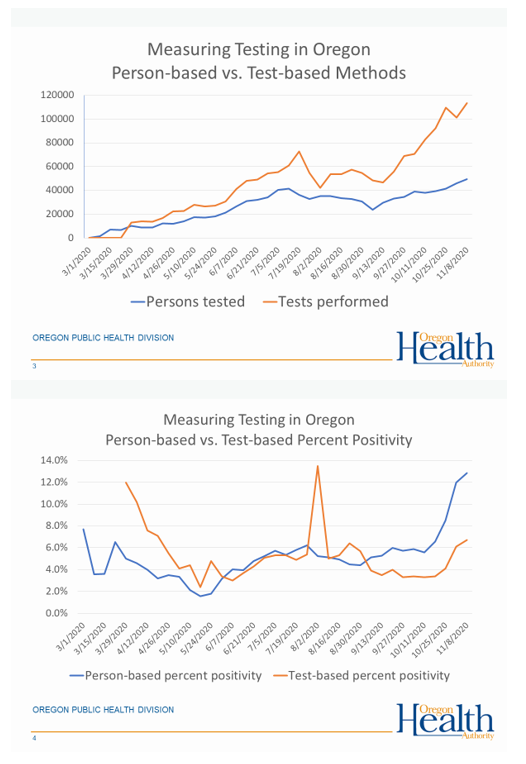 The OHA went into more detail on the change in a press briefing today. (You can watch it here.) Here are some of the points that came out in the briefing with Director Allen and Dr. Melissa Sutton, the lead medical expert for testing strategy:
- When looked at on a per-person basis, one in four Oregonians have received a COVID test since the pandemic began.
- If we look at the most recent reporting period through the two different reporting methods (total individuals vs. total tests), there were 113 thousand tests given vs. the reported number of a little over 40 thousand test-takers.
- Unlike the practice in other states, OHA still recommends that testing be limited to those who have symptoms or have had close, extended contact with individuals who have tested positive. In general, testing in Oregon still needs to be authorized by a medical provider.
- However, testing is now being expanded beyond those limitations in response to the current surge in cases. In select areas that are hard hit by the virus, OHA is now setting up free testing events. These will be open to all comers, including those who are not showing symptoms. [I’ll get you more information on these sites when I receive it.]
- We are seeing increased testing capacity in terms of tests available (particularly if we include the less reliable antigen tests), but that is constrained by a limited number of medical personnel to do the testing.
- Antigen tests are OK, but they do tend to produce false negatives and false positives. They may give people a false sense of confidence if they test negative but in fact are contagious with the virus.
- The PCR nasal swab testing method remains the gold standard, BUT only if the turnaround time is 48 hours or less. With the surge, we’re again seeing a lengthening of turnaround times for commercial labs. As a result, we can expect more use of antigen tests in the near term. It’s a weak test, according to OHA, but a PCR test with a 7-day turnaround is weaker still if the goal is to contain the spread of the virus.
- We are seeing levels of COVID increases, hospitalizations, and deaths here in Oregon that are astounding. However, the OHA medical practitioners remind us that while the numbers are concerning, and hospitals are being stressed, we remain one of the lowest of states for number of infections and deaths. We also continue to have one of the lowest hospitalization rates of any state.
- Finally, it should be remembered that testing is not a cure-all for this disease. It is very important, particularly if it can lead to effective contact tracing. With the current surge in widespread COVID penetration in communities, however, effective contact tracing becomes very difficult. In the end, it’s our actions (face coverings, hand-washing, social distancing, limited gatherings) that will make a real difference.
Here is information on testing from Multnomah County.
Friday Wildfire Recovery/Response Update
No change reported by ODF today. They are still just reporting on the Riverside Fire in Clackamas County. Again, you can follow the remaining firefighting effort at the State of Oregon Fires and Hotspots Dashboard.
The Office of Emergency Management has not released an update on wildfire recovery. However, for the very latest numbers, OEM is now maintaining a real-time Wildfire and Recovery Tracker that will give you up-to-the-moment statistics on a variety of metrics related to recovery efforts.
Also, EPA has an Oregon Fires Recovery Website with a variety of information about the cleanup effort, including information about how residents can get ash and debris removed from their properties at no cost.
Where Are Today’s New Cases?
If we put together the positive test results and new “presumptive” cases reported today, the overall number of new cases for today is 1,306. Most of today’s new cases are from outside the Portland Tri-County area, with record numbers from some of our rural counties. Here is the breakdown by county for today:
Baker (8)
Benton (15)
Clackamas (78)
Clatsop (9)
Columbia (20)
Coos (8)
Crook (2)
Curry (5)
Deschutes (60)
Douglas (39)
Grant (27)
Harney (4)
Hood River (3)
Jackson (84)
Jefferson (11)
Josephine (18)
Klamath (39)
Lake (3)
Lane (91)
Lincoln (7)
Linn (27)
Malheur (23)
Marion (112)
Morrow (3)
Multnomah (337)
Polk (21)
Tillamook (2)
Umatilla (45)
Union (17)
Wasco (13)
Washington (155)
Yamhill (20)
And the Deaths
Oregon’s 809th COVID-19 death is an 81-year-old man in Douglas County who tested positive on Nov. 9 and died on Nov. 14 at Bay Area Hospital.
Oregon’s 810th COVID-19 death is an 83-year old woman in Multnomah County who tested positive on Nov. 11 and died on Nov. 18 at Legacy Mt. Hood Medical Center.
Oregon’s 811th COVID-19 death is a 70-year-old man in Klamath County who tested positive on Nov. 15 and died on Nov. 17 at St. Charles Medical Center in Bend.
Oregon’s 812th COVID-19 death is an 81-year-old woman in Harney County who tested positive on Nov. 12 and died on Nov. 18 at Harney District Hospital.
Additional Graphs:
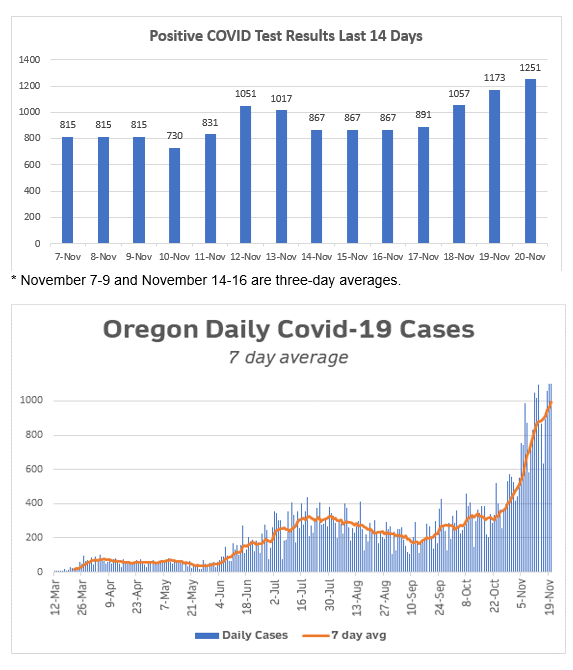 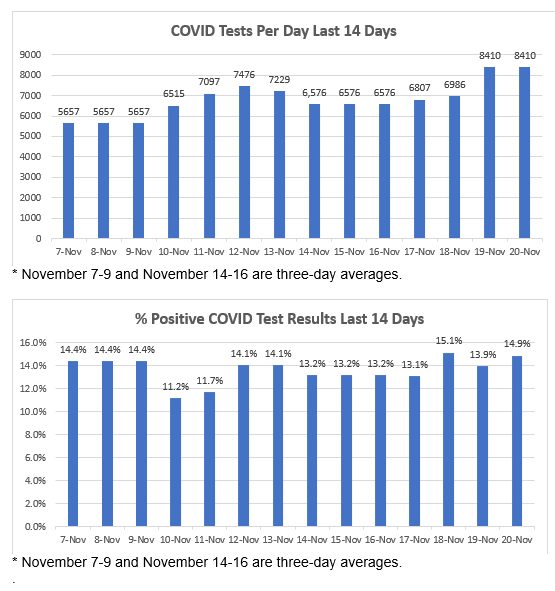   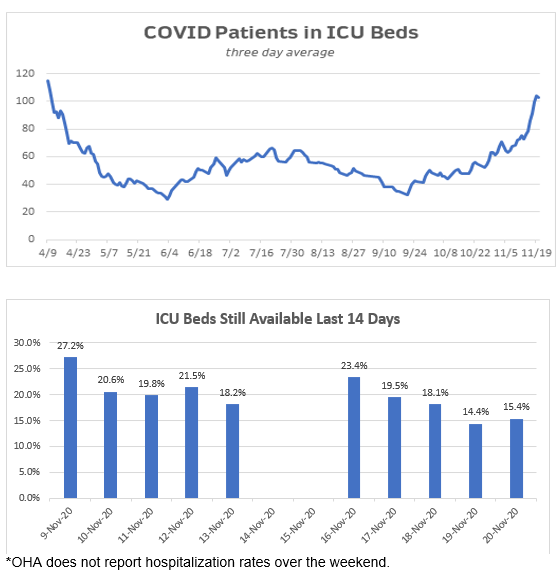 **You can find a breakdown of regional availability here.
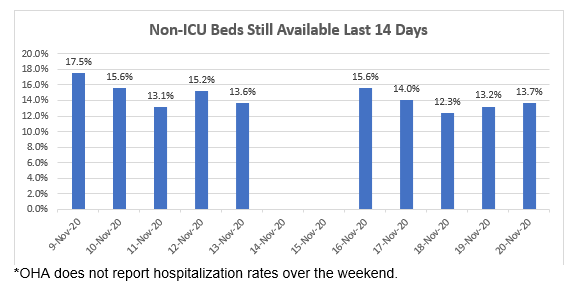 Want to See Past Newsletters?
If there was COVID-related information in a past newsletter that you want to go back to, but find you’ve deleted it, you can always go to my legislative website (senatordembrow.com), click on “News and Information,” and you’ll find them all there. Also, if someone forwarded you this newsletter and you’d like to get it directly, you can sign up for it there.

AND FINALLY,
Here again are some resources that you will find useful:
If the above links are not providing you with answers to your questions or directing you to the help that you need, please consider me and my office to be a resource. We’ll do our best to assist you or steer you in the right direction.
Best,
 Senator Michael Dembrow
District 23
email: Sen.MichaelDembrow@oregonlegislature.gov
web: www.senatordembrow.com
phone: 503-986-1723
mail: 900 Court St NE, S-407, Salem, OR, 97301
|